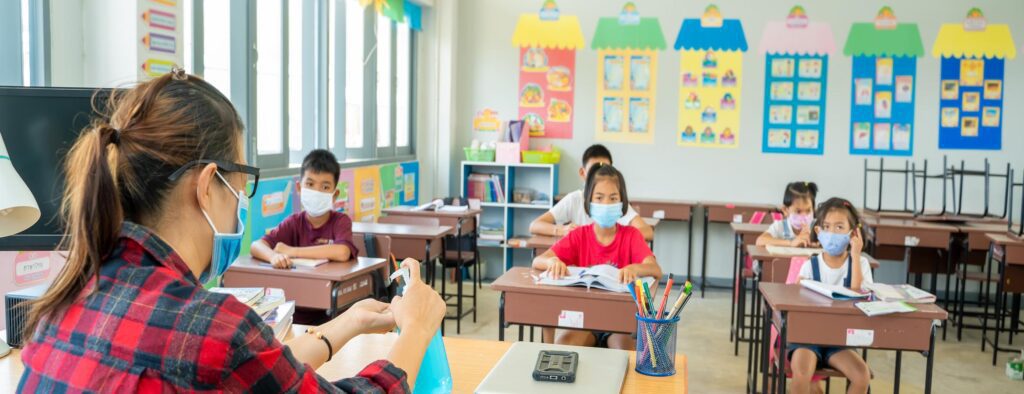
In a classroom setting, education might take precedence, but a clean, healthy environment including proper air filtration is also needed. Protection from ambient particulate matter, which is made up of microscopic solid/liquid particles suspended in the air that can enter the respiratory system and cause long-term damage to students’ lungs. Providing a safe and healthy environment for students to learn is essential to maximizing our future generations’ potential.
Vaccine rollout is increasing at a steady pace across America, which means that more schools are returning to everyday life as inoculation numbers increase. If you are in the business of managing schools or special education facilities, now is not the time to let your guard down. It is more important than ever to stay vigilant in our safety practices in stopping the spread of the virus.
Last month, we covered the essential measures to follow for reopening safely. Since then, President Biden and the Center for Disease Control (CDC) have released updated guidelines. For this article, we will briefly discuss these updates and what your educational facilities should be focusing on as we continue the fight against the coronavirus on the school front.
Summary of updates for April 2021
– Physical distancing guidelines have been updated to represent a minimum of 3 feet between students in classrooms and provide more explicit guidance when a greater distance (such as 6 feet) is recommended.
– It was clarified that ventilation is a part of cleaning and maintaining safe facilities.
– Removed recommendation for physical barriers.
– Clarified the role of community transmission levels in decision-making.
– Added guidance on interventions when covid clusters occur.

Key takeaways for April updates
- Many K-12 schools that have strictly adopted preventive measures have been able to open for in-person learning and stay open.
- The CDC’s K-12 organizational plan outlines a roadmap for schools to safely provide in-person training by implementing preventive measures such as compulsory and proper mask use and physical separation.
- All schools should adopt and layer prevention measures, focusing on universal and proper mask usage and physical separation.
- Additional layers of COVID-19 safety in schools are provided by testing to identify individuals with SARS-CoV-2 infection and teachers and staff vaccination.
Implementing the CDC’s guidelines into your building or facility
Ventilation is an effective COVID-19 prevention technique for schools and childcare services, as it is one component of preserving safe environments. A well-fitting, multi-layer mask can help prevent virus particles from entering the air or being breathed in by the mask wearer. Another way to reduce the number of virus particles in the air is to provide good ventilation. Ventilation, in combination with other preventive measures, can help to minimize the spread of disease. Simply put, the key is to bring in as much outdoor air as possible.
Open windows and doors if it is safe to do so. Simply opening a window or door helps increase outdoor ventilation, minimizing virus particle concentrations in the air. Change the thermostat if it becomes too cold or too hot. If opening windows or doors poses protection or health risk, do not do so (such as falling, exposure to extreme temperatures, or triggering asthma symptoms).
To make open windows more powerful, use child-safe fans. Install fans in windows to safely blow out potentially polluted air while drawing fresh air through other open windows and doors. When the weather permits, consider holding activities, lectures, or lunches outside.
Maximize your HVAC system settings to ensure optimal ventilation, heating, and air conditioning.
Home-based childcare programs should meet requirements established by their state and local regulatory authorities. Set HVAC systems to bring in as much outdoor air as your system will safely allow. Reduce or eliminate HVAC air recirculation when practical and with expert HVAC consultation. Ensure that the ventilation systems are well-maintained and up to date.
They should provide acceptable indoor air quality for each room’s current occupancy level, as specified by ASHRAE Standard 62.1external icon. Where possible, increase the total airflow supply from the HVAC system to occupied spaces. More airflow promotes air mixing and means that any recirculated air is filtered more regularly.
Demand-controlled ventilation (DCV) controls that minimizes air supply based on occupancy or temperature should be turned off. The air supply will be consistent during the day in this manner. Setting the fan control switch from “Auto” to “On” for simple HVAC systems operated by a thermostat ensures the HVAC system provides continuous air filtration and distribution. To refresh the air before arrival and eliminate residual particles at the end of the day, run the HVAC system at total outside airflow for 2 hours before and after the building is occupied.

Filter and clean the air in your childcare center or school.
Improve air filtration as much as possible without reducing airflow substantially. Assemble, mount, and replace the filters according to the manufacturer’s instructions. Consider using portable air cleaners with high-efficiency particulate air (HEPA) filters to improve air cleaning in high-risk areas like a nurse’s office or a sick/isolation bed. Consider using ultraviolet germicidal irradiation (UVGI) as a supplementary treatment in schools and non-home-based childcare programs to inactivate the virus that causes COVID-19, mainly if ventilation filtration options are restricted. Any UVGI device should be designed and installed with the assistance of a trained professional.
Make use of exhaust fans.
Inspect and maintain restroom and kitchen exhaust ventilation systems. Ensure that the restroom and kitchen exhaust fans are turned on and running at total capacity for the school or childcare program duration and the following two hours.
On buses and vans serving schools and nursery programs, air ventilation is essential, as are other measures such as mask usage for children over the age of two and physical separation. If it is not a safety or health threat, keep the vehicle windows open. Having more windows open is preferable, but even a few cracked windows are preferable to leaving all windows locked.

Advanced Filtration Concepts is a
Certified Veteran-Owned Small Business.
